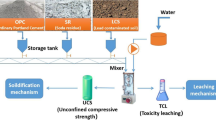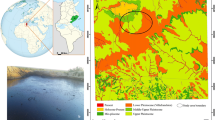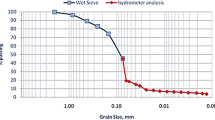Abstract
In this study, the efficiency of solidification and stabilization (S/S) processes of aliphatic hydrocarbons (AHs) contaminated soil in the Kharg island oil terminal was investigated using Portland cement and activated carbon (AC) and, thus, the best mix design was determined based on the pollution leaching and unconfined compressive strength. Regarding the unconfined compressive strength of samples with a curing time of 28 days, the compressive strength decreased with increasing the AC; also, the maximum unconfined compressive strength belonged to the sample contains of 25% cement, 1% AC (C25 AC1) and strength of 4441 kPa. The leaching test results through the toxicity characteristic leaching procedure method demonstrated that an increase in amount of AC leads to decrease in leaching of aliphatic compounds; however, the same trend was not perceived in the case of cement; indeed, the reduction of aliphatic compounds was not observed in all samples containing the increased amount of cement. The synergistic approach for cement and AC is needed to reach an ideal stabilization of AHs. Therefore, the amount of 25% cement and 3% AC (C25 AC3) was concluded as the best mix design of S/S for AHs contaminated soils.







Similar content being viewed by others
References
Arafat HA, Hebatpuria VM, Rho HS, Pinto NG, Bishop PL, Buchanan RC (1999) Immobilization of phenol in cement-based solidified/stabilized hazardous wastes using regenerated activated carbon: role of carbon. J Hazard Mater 70:139–156
Askari K, Pollard S (2005) The UK approach for evaluating human health risks from petroleum hydrocarbon in soils: Environment Agency. Science Report P5-080 TR3. http://www.ibrarian.net/navon/paper/w_w_w_environment_agency_gov_.pdf?paperid=12149935. Accessed 1 Feb 2005
ASTM D1633-00 (2007) Standard test methods for compressive strength of molded soil-cement cylinders 1. ASTM International, West Conshohocken. doi:10.1520/D1633-00R07
ASTM D2216-10 (2010) Standard test methods for laboratory determination of water (moisture) content of soil and rock by mass. ASTM International, West Conshohocken. doi:10.1520/D2216-10.N
ASTM D2487-11 (2011) Standard practice for classification of soils for engineering purposes (unified soil classification system). ASTM International, West Conshohocken. doi:10.1520/D2487-11
ASTM D4318-05 (2005) Standard test methods for liquid limit, plastic limit, and plasticity index of soils. ASTM International, West Conshohocken. doi:10.1520/D4318-05
ASTM D4972-13 (2013) Standard test method for pH of soils. ASTM International, West Conshohocken. doi:10.1520/D4972
ASTM D854-14 (2014) Standard test methods for specific gravity of soil solids by water pycnometer. ASTM International, West Conshohocken. doi:10.1520/D0854-14
Cioffi R, Maffucci L, Santoro L, Glasser FP (2001) Stabilization of chloro-organics using organophilic bentonite in a cement-blast furnace slag matrix. Waste Manag 21:651–660
Cole GM (1994) Assessment and remediation of petroleum contaminated sites. Lewis Publishers, Boca Raton
Conner JR, Hoeffner SL (1998) A critical review of stabilization/solidification technology. Crit Rev Environ Sci Technol 28:397–462
Gitipour S, Mohebi M, Taheri E (2011) Evaluation of carcinogenic risk due to accidental ingestion of PAHs in contaminated soils. CLEAN Soil Air Water 39:820–826. doi:10.1002/clen.201000480
Jones LW (1990) Interference mechanisms in waste stabilization/solidification processes. J Hazard Mater 24:83–88
Karamalidis AK, Voudrias EA (2007) Cement-based stabilization/solidification of oil refinery sludge: leaching behavior of alkanes and PAHs. J Hazard Mater 148:122–135
Kogbara RB, Al-Tabbaa A (2011) Mechanical and leaching behaviour of slag-cement and lime-activated slag stabilised/solidified contaminated soil. Sci Total Environ 409:2325–2335
LaGrega MD, Buckingham PL, Evans JC (2001) Hazardous waste management, related information: McGraw-Hill series in water resources and environmental engineering. McGraw-Hill, Boston
Maier RM, Pepper IL, Gerba CP (2000) Environmental microbiology. Academic Press, San Diego
Marwa SA, Abir A (2007) Stabilisation/solidification of synthetic petroleum drill cuttings. J Hazard Mater 150:410–421
Montgomery DM, Sollars CJ, Perry R, Tarling SE, Barnes P, Henderson E (1991) Treatment of organic-contaminated industrial wastes using cement-based stabilization/solidification–I. Microstructural analysis of cement-organic interactions. Waste Manag Res. 9:103–111
Richter P, Jiménez M, Salazar R, Maricán A (2006) Ultrasound-assisted pressurized solvent extraction for aliphatic and polycyclic aromatic hydrocarbons from soils. J Chromatogr A 1132:15–20
Serrano A, Gallego M (2006) Continuous microwave-assisted extraction coupled on-line with liquid liquid extraction: determination of aliphatic hydrocarbons in soil and sediments. J Chromatogr A 1104:323–330
Shi C, Spence R (2004) Designing of cement-based formula for solidification/stabilisation of hazardous, radioactive, and mixed wastes. Crit Rev Environ Sci Technol 34:391–417
Spence RD, Shi C (2005) Stabilization and solidification of hazardous, radioactive and mixed wastes. Waste Manag. doi:10.1016/S0956-053X(97)88232-3
Stroud JL, Paton GI, Semple KT (2007) Microbe-aliphatic hydrocarbon interactions in soil: implications for biodegradation and bioremediation. J Appl Microbiol 102:1239–1253. doi:10.1111/j.1365-2672.2007.03401.x
Tuncan A, Tuncan M, and Koyuncu H (1996) Pilot field study of petroleum contaminated waste stabilization. In: Proceeding 3th international symposium on environmental geotechnology, Sandiago, USA, vol 2, pp 393–404
US Environmental Protection Agency (1992) Method 1311: toxicity characteristic leaching procedure (TCLP). In: test methods for evaluating solid waste: physical/chemical methods; SW-846. Washington DC. pp: 1–36. doi:10.1017/CBO9781107415324.004
US Environmental Protection Agency (1996) Method 3540 C: Soxhlet extraction. Test Methods SW-846, 3rd ed, Revision 3. EPA, Washington DC
US Environmental Protection Agency (2007) Treatment technologies for site cleanup: annual status report, solid waste and emergency response (5203P). Washington DC. doi:10.1007/s13398-014-0173-7.2
Vipulanandan C (1995) Effect of clays and cement on the solidification/stabilisation of phenol contaminated soils. Waste Manage 15:399–406
Zhang J, Pl Bishop (2002) Stabilization/solidification (S/S) of mercury-containing wastes using reactivated carbon and Portland cement. J Hazard Mater 92:199–212
Acknowledgements
The authors would like to express their sincere gratitude to the Faculty of Environment at University of Tehran, for supporting the lab works through the supply of Waste Laboratory facilities. The authors also acknowledge the Iranian Oil Terminal Company (IOTC) for the financial support (Project No. 910381000031).
Author information
Authors and Affiliations
Corresponding author
Rights and permissions
About this article
Cite this article
Firouzbakht, S., Gitipour, S. & Rooz, A.F.H. Cement-Based and AC-Based Solidification/Stabilization Processes of Aliphatic Hydrocarbons Contaminated Soils in Kharg Island Oil Terminal. Int J Environ Res 11, 439–448 (2017). https://doi.org/10.1007/s41742-017-0039-x
Received:
Revised:
Accepted:
Published:
Issue Date:
DOI: https://doi.org/10.1007/s41742-017-0039-x




